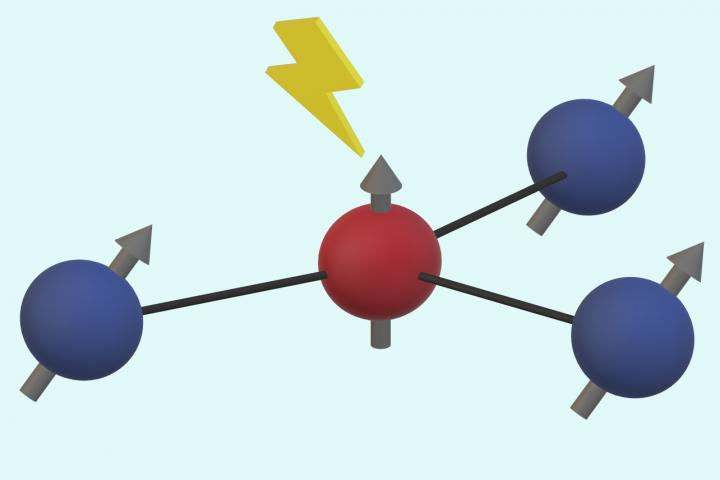Mar 12 2020
A novel method for quantum error correction, developed as part of a U.S. Army project, could offer a significant advance toward practical quantum computers, sensors, and distributed quantum information.
 In a diamond crystal, three carbon atom nuclei (shown in blue) surround an empty spot called a nitrogen vacancy center, which behaves much like a single electron (shown in red). The carbon nuclei act as quantum bits, or qubits, and it turns out the primary source of noise that disturbs them comes from the jittery “electron” in the middle. By understanding the single source of that noise, it becomes easier to compensate for it, providing a key step toward quantum computing. Image Credit: MIT.
In a diamond crystal, three carbon atom nuclei (shown in blue) surround an empty spot called a nitrogen vacancy center, which behaves much like a single electron (shown in red). The carbon nuclei act as quantum bits, or qubits, and it turns out the primary source of noise that disturbs them comes from the jittery “electron” in the middle. By understanding the single source of that noise, it becomes easier to compensate for it, providing a key step toward quantum computing. Image Credit: MIT.
This progress might allow the U.S. Army to possibly solve problems that were intractable earlier or deploy sensors with higher electric and magnetic field sensitivities.
The technique was devised by scientists from Massachusetts Institute of Technology and could be applied to mitigate specific types of random fluctuations, or noise, which have been a barrier to quantum computing for a long time. Such random fluctuations can destroy the data stored in these devices.
The study, which was funded by the U.S. Army, was reported in Physical Review Letters and involves detecting the types of noise that are the most probable, instead of casting a wider net to try to arrest all the potential sources of disturbance.
The team learned that we can reduce the overhead for certain types of error correction on small scale quantum systems. This has the potential to enable increased capabilities in targeted quantum information science applications for the DOD.
Dr Sara Gamble, Program Manager, Army Research Office
The Army Research Office is an element of the U.S. Army Combat Capabilities Development Command’s Army Research Laboratory.
The particular quantum system with which the researchers are working includes carbon nuclei distributed close to a specific type of defect in a diamond crystal. This defect is known as a nitrogen vacancy center and behaves similar to single, isolated electrons. The presence of such defects allows nearby carbon nuclei to be controlled.
However, the researchers discovered that a major portion of the noise influencing these nuclei arises from a single source: random fluctuations that occur in the nearby defects. It is possible to model this noise source accurately, and inhibiting its effects could have a significant effect because other sources of noise are comparatively trivial.
They identified that the noise arises from a single central defect, or a single central electron that tends to bounce around at random. It has a tendency to jitter, which, in turn, is felt by all the adjacent nuclei, in a predictable manner that can be fixed. The potential to successfully use this targeted correction is the major achievement of this study.
Thus far, the study is theoretical. However, the researchers have been working actively on a laboratory demonstration of this concept in action.
If the demonstration works as predicted, this study could become a crucial component of near and long-term future quantum-based technologies of different types, such as quantum computers and sensors.